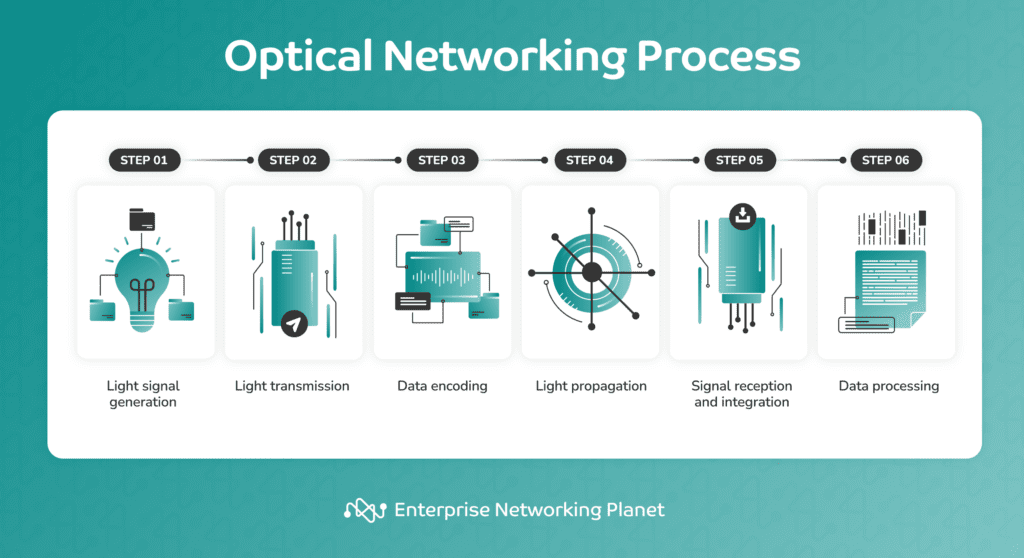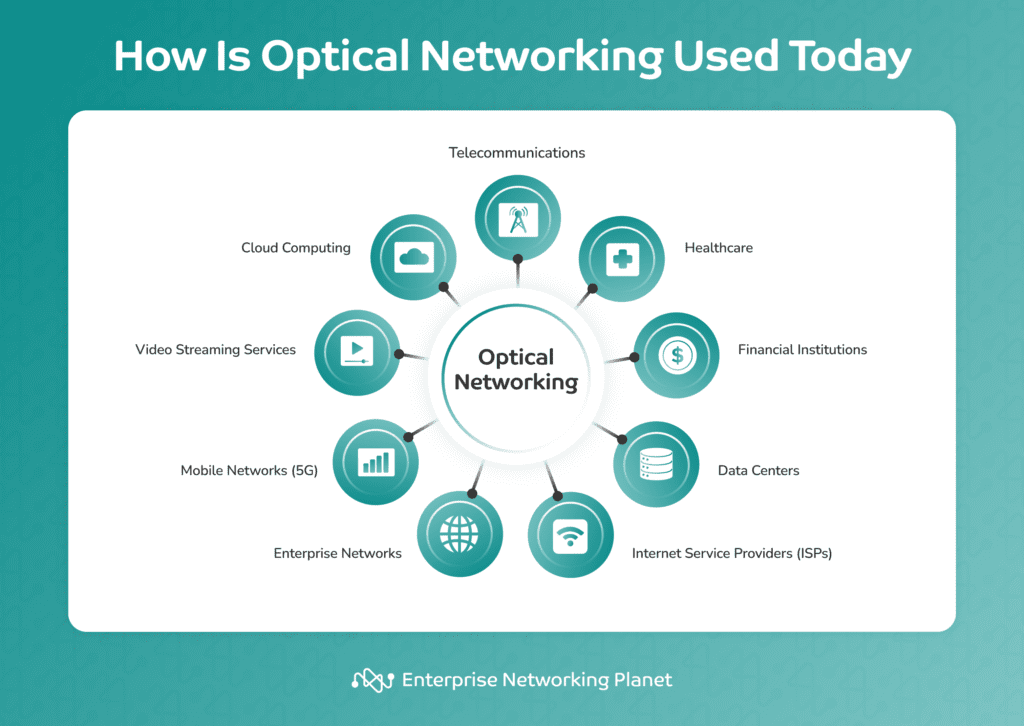Optical networking is a know-how that makes use of gentle alerts to transmit information via fiber-optic cables. It encompasses a system of elements, together with optical transmitters, optical amplifiers, and fiber-optic infrastructure to facilitate high-speed communication over lengthy distances.
This know-how helps the transmission of huge quantities of knowledge with excessive bandwidth, enabling sooner and extra environment friendly communication in comparison with conventional copper-based networks.
Featured Companions: Community Monitoring Software program
Major elements of optical networking
The principle elements of optical networking embody fiber optic cables, optical transmitters, optical amplifiers, optical receivers, transceivers, wavelength division multiplexing (WDM), optical switches and routers, optical cross-connects (OXCs), and optical add-drop multiplexers (OADMs).
Fiber optic cables
Fiber optic cables are a sort of high-capacity transmission medium with glass or plastic strands often called optical fibers.
These fibers carry gentle alerts over lengthy distances with minimal sign loss and excessive information switch charges. A cladding materials surrounds the core of every fiber, reflecting the sunshine alerts again into the core for environment friendly transmission.
Fiber optic cables are extensively utilized in telecommunications and networking purposes as a result of immunity to electromagnetic interference and decreased sign attenuation in comparison with conventional copper cables.
Optical transmitters
Optical transmitters convert electrical alerts into optical alerts for transmission over fiber optic cables. Their main operate is to modulate a light-weight supply, often a laser diode or light-emitting diode (LED), in response to electrical alerts representing information.
Optical amplifiers
Strategically positioned alongside the optical fiber community, optical amplifiers increase the optical alerts to take care of sign power over prolonged distances. This part compensates for sign attenuation and permits the gap alerts to journey with out costly and complicated optical-to-electrical sign conversion.
The first kinds of optical amplifiers embody:
- Erbium-doped fiber amplifier (EDFA): EDFAs make use of erbium-doped optical fiber. When uncovered to gentle at a particular wavelength, erbium ions inside the fiber soak up and re-emit photons, amplifying the optical sign. Usually used within the 1550 nm vary, EDFA is a key part for long-haul communication.
- Semiconductor optical amplifier (SOA): SOAs amplify optical alerts via semiconductor supplies. Incoming optical alerts induce stimulated emission inside the semiconductor, leading to sign enchancment. SOAs focus on short-range and entry community eventualities.
- Raman amplifier: Raman amplifiers use the Raman scattering impact in optical fibers. Pump gentle at a distinct wavelength interacts with the optical sign, transferring vitality and intensifying it. The sort of amplifier is flexible and may function at numerous wavelengths, together with the generally used 1550 nm vary.
Optical receivers
On the reception finish of the optical hyperlink, optical receivers remodel incoming optical alerts again into electrical alerts.
Transceivers
Transceivers, brief for transmitter-receiver, are multifunctional units that mix the functionalities of each optical transmitters and receivers right into a single unit, facilitating bidirectional communication over optical fiber hyperlinks. They flip electrical alerts into optical alerts for transmission, and convert obtained optical alerts again into electrical alerts.
Wavelength division multiplexing (WDM)
Wavelength division multiplexing (WDM) permits the simultaneous transmission of a number of information streams over a single optical fiber. The elemental precept of WDM is to make use of totally different wavelengths of sunshine to hold unbiased information alerts, supporting elevated information capability and efficient utilization of the optical spectrum.
WDM is extensively utilized in long-haul and metro optical networks, offering a scalable and cost-effective resolution for assembly the rising demand for high-speed and high-capacity information transmission.
Optical add-drop multiplexers (OADMs)
Optical add-drop multiplexers (OADMs) are main elements in WDM optical networks, providing the aptitude to selectively add (inject) or drop (extract) particular wavelengths of sunshine alerts at community nodes. OADMs assist refine the info circulate inside the community.
Optical switches and routers
Each optical switches and routers contribute to the event of superior optical networks with options for high-capacity, low-latency, and scalable communication techniques that may meet the altering calls for of recent information transmission.
- Optical switches selectively route optical alerts from one enter port to a number of output ports. They’re necessary in establishing communication paths inside optical networks. These units work by controlling the path of optical alerts with out changing them into electrical alerts.
- Optical routers, then again, direct information packets on the community layer primarily based on their vacation spot addresses. They function within the optical area, sustaining the integrity of the optical alerts with out changing them into electrical kind.
Optical cross-connects (OXCs)
Optical cross-connects (OXCs) allow the reconfiguration of optical connections by selectively routing alerts from enter fibers to desired output fibers. By streamlining wavelength-specific routing and speedy reconfiguration, OXCs contribute to the flexibleness and low-latency traits of superior optical communication techniques.
How optical networking works
Optical networking capabilities by harnessing gentle alerts to transmit information via fiber-optic cables, making a speedy communication framework. The method includes gentle sign era, gentle transmission, information encoding, gentle propagation, sign reception and integration, and information processing.

1. Mild sign era
The optical networking course of begins by changing information into gentle pulses. This conversion is usually achieved utilizing laser sources to safe the profitable illustration of knowledge.
2. Mild transmission
The system sends gentle pulses carrying information via a fiber optic cable throughout this section. The sunshine travels inside the cable’s core, bouncing off the encompassing cladding layer as a result of whole inner reflection. This lets the sunshine journey nice distances with minimal loss.
3. Information encoding
Information is then encoded onto the sunshine pulses, introducing variations in both the sunshine’s depth or wavelength. This course of is tailor-made to fulfill the wants of enterprise purposes, guaranteeing a seamless integration into the optical networking framework.
4. Mild propagation
The sunshine pulses propagate via the fiber-optic cables, delivering high-speed and dependable connectivity inside the community. This leads to the swift and safe transmission of necessary info between totally different areas.
5. Sign reception and integration
On the receiving finish of the community, photosensitive units, like photodiodes, detect the incoming gentle alerts. The photodiodes then convert these gentle pulses again into electrical alerts, bettering optical networking integration.
6. Information processing
{The electrical} alerts bear additional processing and interpretation by digital units. This stage consists of decoding, error correction, and different operations vital to ensure the info transmission accuracy. The processed information is used for numerous operations, supporting key capabilities, corresponding to communication, collaboration, and data-driven decision-making.
8 kinds of optical networks
There are numerous several types of optical networks serving numerous functions. Essentially the most generally used ones are mesh networks, passive optical community (PON), free-space optical communication networks (FSO), wavelength division multiplexing (WDM) networks, synchronous optical networking (SONET) and synchronous digital hierarchy (SDH), optical transport community (OTN), fiber to the house (FTTH)/fiber to the premises (FTTP), and optical cross-connect (OXC).
1. Mesh networks
Optical mesh networks interconnect nodes via a number of fiber hyperlinks. This supplies redundancy and permits for dynamic rerouting of site visitors in case of hyperlink failures, enhancing the community’s reliability.
- Typical use: Usually utilized in large-scale, mission-critical purposes the place community resilience and redundancy are important, corresponding to in information facilities or core spine networks.
2. Passive optical community (PON)
PON is a fiber-optic community structure that brings optical cabling and alerts to the top person. It makes use of unpowered optical splitters to distribute alerts to a number of customers, making it passive.
- Typical use: “Final-mile” connectivity, offering high-speed broadband entry to residential and enterprise customers.
3. Free-space optical communication (FSO)
FSO makes use of free area to transmit optical alerts between two factors.
- Typical use: Excessive-speed communication in environments the place it’s impractical or difficult to put optical fibers, corresponding to city areas or army functions.
4. Wavelength division multiplexing (WDM)
WDM makes use of totally different wavelengths of sunshine for every sign, permitting for elevated information capability. Sub-types of WDM embody coarse wavelength division multiplexing (CWDM) and dense wavelength division multiplexing (DWDM).
- Typical use: CWDM is used for short-distance, metro-area networks, whereas DWDM is for long-haul and high-capacity communication.
5. Synchronous optical networking (SONET)/synchronous digital hierarchy (SDH)
SONET and SDH are standardized protocols for transmitting massive quantities of knowledge over lengthy distances utilizing fiber-optic cables. North America extra generally makes use of SONET, whereas worldwide industries use SDH.
- Typical use: SONET and SDH are designed for high-speed, long-distance transmission of voice, information, and video. They provide a synchronous and dependable transport infrastructure utilized in telecommunications backbones and provider networks.
6. Optical transport community (OTN)
OTN transports digital alerts within the optical layer of communication networks. It comes with capabilities like error detection, efficiency monitoring, and fault administration options.
- Typical use: Used along with WDM to maximise the resilience of long-haul transmissions.
7. Fiber to the house (FTTH)/fiber to the premises (FTTP)
FTTH and FTTP confer with the deployment of optical fiber on to residential or enterprise premises, offering high-speed web entry.
- Typical use: FTTH and FTTP assist bandwidth-intensive purposes like video streaming, on-line gaming, and different broadband providers.
8. Optical cross-connect (OXC)
OXC facilitates the switching of optical alerts with out changing them to electrical alerts.
- Typical use: Principally utilized in large-scale optical networks by telecommunication carriers to handle site visitors.
How optical networking is used at the moment
Varied industries and domains at the moment use optical networking for high-speed and environment friendly information transmission. These embody telecommunications, healthcare, monetary organizations, information facilities, web service suppliers (ISPs), enterprise networks, 5G networks, video streaming providers, and cloud computing.

Telecommunications
Optical networking is the muse of telephone and web techniques. At present, optical networking stays pivotal in telecommunications, connecting cell websites, guaranteeing excessive availability via dynamic site visitors rerouting, and enabling high-speed broadband in metropolitan areas and long-distance networks.
Healthcare
For healthcare, optical networking ensures speedy and safe transmission of medical information, expediting distant diagnostics and telemedicine providers.
Monetary organizations
Monetary organizations use this know-how for quick and secure information transmission, which is indispensable for actions like high-frequency buying and selling and connecting branches seamlessly.
Information facilities
Optical networking in information facilities hyperlinks servers and storage items, providing a high-bandwidth and low-latency infrastructure for dependable information communication.
Web service suppliers (ISPs)
Web service suppliers (ISPs) make use of optical networking to supply broadband providers, utilizing fiber-optic connections for faster web entry.
Enterprise networks
Giant companies use inner optical networking to attach places of work and information facilities, sustaining high-speed and scalable communication inside their infrastructure.
Cellular networks (5G)
For 5G cell networks, optical networking permits for elevated information charges and low-latency necessities. Fiber-optic connections hyperlink 5G cell websites to the core community, bringing bandwidth for numerous purposes.
Video streaming providers
Optical networks allow clean information transmission to ship high-quality video content material by way of streaming platforms for a extra optimistic viewing expertise.
Cloud computing
Cloud service suppliers depend on optical networking to interconnect information facilities to offer scalable and high-performance cloud-based providers.
Historical past of optical networking
The collaborative efforts of a number of optical networking corporations and distinguished people have considerably formed the optical networking panorama as we all know it at the moment.
- 1792: French inventor Claude Chappe invented the optical semaphore telegraph, one of many earliest examples of an optical communication system.
- 1880: Alexander Graham Bell patented the Photophone, an optical phone system. Nevertheless, his first invention, the phone, was deemed to be extra sensible.
- 1966: Sir Charles K. Kao and George A. Hockham proposed that fibers made from ultra-pure glass might transmit gentle for distances of kilometers with no whole lack of sign.
- 1996: The primary commercially accessible 16-channel DWDM system was introduced by Ciena Company.
- Nineteen Nineties: Organizations started to use fiber optics in enterprise native space networks (LANs) to attach Ethernet switches and IP routers.
- Speedy enlargement of optical networks to assist the rising demand pushed by the web increase.
- Organizations started to make use of optical amplification to lower the necessity for repeaters, and extra companies carried out WDM to spice up information capability. This marked the beginning of optical networking, as WDM grew to become the know-how of alternative for increasing the bandwidth of fiber-optic techniques.
- 2009: The time period software-defined networking (SDN) was first coined in an MIT review article.
- Current: 5G started becoming available in 2020.
- Research and development for photonic applied sciences continues. Photonics options have extra reliable laser capabilities and may switch gentle at historic speeds, letting system producers unlock broader purposes and put together next-generation merchandise.
Traits in optical networking
Traits in optical networking, corresponding to 5G integration, elastic optical networks, optical community safety, interconnects in information facilities, and inexperienced networking spotlight the continuing evolution of the know-how to fulfill the calls for of recent applied sciences and purposes.
5G integration
Optical networking allows the mandatory high-speed, low-latency connections to deal with the info calls for of 5G purposes. 5G integration makes positive that you just get quick and dependable connectivity for actions corresponding to streaming, gaming, and rising applied sciences like augmented actuality (AR) and digital actuality (VR).
Coherent optics developments
Ongoing developments in coherent optics know-how contribute to greater information charges, longer transmission distances, and elevated capability over optical networks. That is important for accommodating the rising quantity of knowledge site visitors and supporting purposes that want excessive bandwidth.
Edge computing
Integration of optical networking with edge computing reduces latency and elevates the efficiency of purposes and providers that decision for real-time processing. That is crucial for apps and providers needing real-time responsiveness, corresponding to autonomous automobiles, distant medical procedures, and industrial automation.
Software program-defined networking (SDN) and community operate virtualization (NFV)
Adopting SDN and NFV in optical networking results in higher flexibility, scalability, and efficient useful resource use. This lets operators dynamically allocate assets, optimize community efficiency, and reply rapidly to altering calls for, bettering general community effectivity.
Elastic optical networks
Elastic optical networks permit for dynamic changes to the spectrum and capability of optical channels primarily based on site visitors calls for. This promotes optimum useful resource use and minimizes the danger of congestion throughout peak utilization intervals.
Optical community safety
Specializing in bolstering the safety of optical networks, together with encryption strategies, is necessary for shielding delicate information and communications. As cyberthreats develop into extra refined, safeguarding your networks turns into paramount, particularly when transmitting delicate info.
Optical interconnects in information facilities
The rising demand for high-speed optical interconnects in information facilities is pushed by the necessities of cloud computing, large information processing, and synthetic intelligence purposes. Optical interconnects have the bandwidth to deal with massive volumes of knowledge inside information middle environments.
Inexperienced networking
Efforts to make optical networks extra energy-efficient and environmentally-friendly align with broader sustainability objectives. Inexperienced networking practices play a key function in reducing the environmental influence of telecommunications infrastructure, making it extra sustainable in the long term.
Backside line: Optical networking is right here to remain
The development of optical networking has been instrumental in shaping the historical past of pc networking. As the necessity for sooner information transmission strategies grew with the event of pc networks, optical networking supplied an answer. Through the use of gentle for information transmission, this know-how enabled the creation of high-speed networks that we use at the moment.
Because it grows, optical networking is doing extra than simply offering sooner web speeds. Optical community safety, as an example, can defend your group in opposition to rising cyberthreats, whereas developments like inexperienced networking could make your telecommunication infrastructure extra sustainable over time.
Learn our information on high optical networking corporations and get to know the main optical networking options you possibly can think about for your online business.


